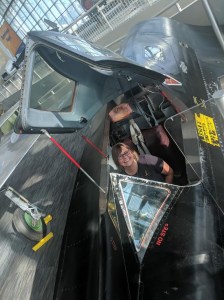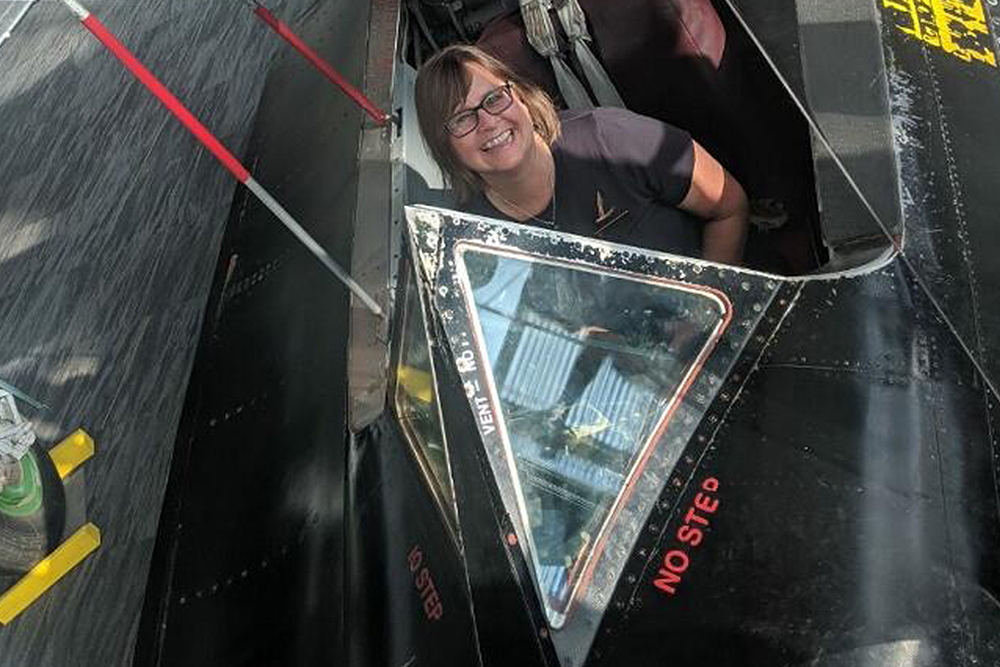Precious Cargo: Our aircraft carry the gift of sight
Share

Corneal transplant recipient Debby Mulligan in the cockpit of an SR-71 Blackbird aircraft.
Debby Mulligan loves to dance. The Alaska Airlines airport employee from Portland especially loves ballroom dancing—swirling in step-patterns, moving rhythmically and expressing the music’s characteristics. She’s danced on the ballroom circuit for eight years.

But a rare eye disease that cropped up over her adult years nearly cost Mulligan her dancing—and her livelihood. In her 20’s, due to a failing cornea—the clear front surface of the eye—she had difficulty seeing, even with glasses. In her 30’s she could no longer read the big “E” on the eye chart. She was going blind.
Over the last 20 years, Mulligan has had three different corneal transplants, which have given her the ability to see again. “I am incredibly grateful every day for having my sight back, thanks to the generosity of donors,” she says.
The intricate dance of scheduling the surgery and having donor tissue available to transplant makes timeliness a priority for doctors and their patients in need of crucial transplant surgeries like Mulligan’s.
“Everyone is ready and waiting for the donation to arrive,” Mulligan says.
The journey often involves her very own airline.
Working with Seattle global health organization SightLife, Alaska Air Cargo regularly ships corneas via its GoldStreak Package Express overnight service. The tissue, which comes from donors who made the selfless decision to help others before passing away, goes to labs and eye banks around the U.S., and sometimes overseas. In a year, Alaska will ship more than 5,000 corneas eventually bound for patients waiting for corneal transplants, according to Rick Bendix, the airline’s cargo marketing & business development program manager.
“We’re literally carrying the gift of sight,” says Ravelle Snyder, regional cargo sales manager who works with SightLife on the precious cargo. “Our employees often hand-carry these GoldStreak packages to the aircraft, taking personal responsibility to ensure that the tissue is safe at all times during transit.”

Recently, when a SightLife courier arrived right at the acceptance cutoff without pre-booking, we quickly made it happen, according to Helene Romero, of Alaska’s airfreight team in Seattle, who knows the importance of timeliness in these shipments. Typically, shorter times between donation and corneal transplant result in better outcomes for patients.
Speed, service and reliability are why shippers love GoldStreak.
“It’s reassuring to work with a partner who values the gift of sight as much as we do,” says SightLife’s COO Jim McCorkle. “When we have a deadline to get tissue to the lab, the Alaska Airlines staff is always willing to help radio a driver to prioritize our shipment since time is of the essence when it comes to sight-restoring, life-transforming corneal transplants.”
Mulligan’s journey recently came full circle. When her father passed, he was too elderly to donate his corneas for sight-restoring transplants, but the family supported the option to donate for research or training.
“From recipients like me, from the families who support donation of their loved ones, every hospital worker, eye bank worker, and transportation worker—thank you to all who are part of the donor network. It’s so incredibly important,” she says.
